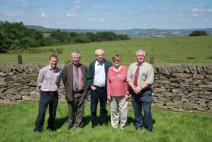Millions of people who watched Stage 2 of the Tour de France on TV may have taken for granted the lush moorlands on Holme Moss as the cyclists rushed over the summit.
But Lord Smith, chair of the Environment Agency, knows that just a few years ago they would have been passing a black, barren, eroding landscape where no plants grew and polluted water rushed down into reservoirs and streams.

Green growth has been restored to Holme Moss and surrounding moors in the South Pennines thanks to the hard work of the Moors for the Future Partnership over the past 11 years, and its widespread benefits should be a lesson for other areas, said Lord Smith on a farewell visit to the Peak District.
Having watched progress on moorland restoration since the Environment Agency became a key partner in Moors for the Future Partnership in 2007, he wanted to pay tribute to the work being done before he steps down in September, and to back the drive for fresh funding for the future.
“The Moors for the Future Partnership is not only incredibly valuable for the environment, landscape and people of the Peak District and South Pennine moorlands, but it is a very clear demonstration of how real partnership working between different agencies, authorities and landowners can produce tangible benefits,” said Lord Smith.
“I hope that others elsewhere around the country are going to learn that lesson.
“I’ve always been really impressed by the work that’s going on here, and I wanted to see how it was progressing before I leave the Environment Agency, and also how other parts of the country can benefit from what’s happening here.”
The Moors for the Future Partnership, whose members include the Peak District National Park Authority, Environment Agency, Natural England, National Trust, RSPB, Severn Trent Water, United Utilities and Yorkshire Water, presented Lord Smith with a book of moorland photographs as thanks for his unfailing support and advocacy while he has chaired the Environment Agency.
Moors for the Future Partnership staff briefed him on benefits so far for people and wildlife.
They include:
- 27 sq km of bare peat restoration which has made the moors a place to enjoy and protect for thousands of people rather than somewhere to be feared and avoided.
- A bio-diverse landscape where birds, plants, insects and mammals are returning.
- Purer drinking water, free of colour and metals without expensive treatment.
- Reduced flood risk by reducing run-off and delaying peak flows.
- Improved river quality for fish, plants, insects, birds and mammals.
- Better prospects for climate change by preserving the UK’s largest store of carbon in the ground.
Over the partnership’s 11 years they will have airlifted 65,000 bags of heather cuttings onto the moors – enough to cover every inch of road ridden by the Tour de France riders in Yorkshire and London.
They have also spread 11,500 tonnes of fertiliser and 153 tonnes of grass seed, flown in 4,500 tonnes of stone to block eroding gullies, planted 700,000 plug plants, and scattered 236 million gel-beads of sphagnum moss – a technique they specially developed.
Working with the Forestry Commission, Natural England, Environment Agency, National Trust and RSPB they have also launched the biggest native woodland restoration and creation scheme in the country in the steep cloughs leading down from the moors, which aims to provide benefits to biodiversity, downstream flood risk, water quality and enhance the landscape character.
In addition they have set up a Community Science Programme to involve hundreds of local volunteers in scientific monitoring and surveys, compiled an oral history archive of moorland life, restored footpaths and created audio-trails, videos and apps to help people learn about the moors.
From one project back in 2003, supported by the Heritage Lottery Fund, the Partnership now has 20 different projects underway.
For example since 2010 the EU LIFE+ Fund has supported the MoorLIFE project with a five-year grant of £5 million.
The partners, who also put in their own funding, staff and resources, are now applying for funding to continue the projects to 2020 and beyond.